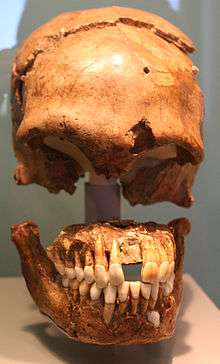Le Moustier

Le Moustier is an archeological site consisting of two rock shelters in Peyzac-le-Moustier, a village in the Dordogne, France. It is known for a fossilized skull of the species Homo neanderthalensis that was discovered in 1909. The Mousterian tool culture is named after Le Moustier, which was first excavated from 1863 by the Englishman Henry Christy and the Frenchman Édouard Lartet.
The Le Moustier skull is estimated to be approximately 45,000 years old.[1] Its characteristics include a large nasal cavity and a somewhat less developed brow ridge and occipital bun, as might be expected in a juvenile.
-

Upper shelter
-

Lower shelter
-

Flint handaxe, excavated 1863, British Museum
-

A box of side scrapers excavated by Lartet and Christy
References
- ↑ Australian Museum[Retrieved 2012-01-06]
See also
- List of fossil sites (with link directory)
- List of hominina (hominid) fossils (with images)
External links
 Media related to Le Moustier at Wikimedia Commons
Media related to Le Moustier at Wikimedia Commons
Coordinates: 44°59′38″N 01°03′36″E / 44.99389°N 1.06000°E